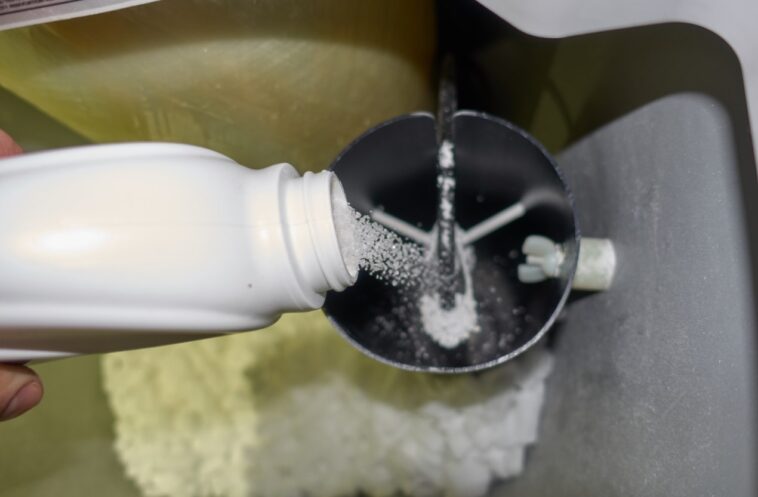Water softeners are essential household appliances that help improve water quality by reducing the presence of minerals, primarily calcium and magnesium, which cause hardness.
To ensure your water softener continues to operate efficiently and provide you with soft, high-quality water, regular maintenance is crucial.
In this article, we’ll explore the importance of water softener maintenance and provide you with a step-by-step guide to keep your water softener in top condition.
What Is a Water Softener?
A water softener is a specialized household appliance designed to address the issue of hard water. Hard water contains an excess of minerals, primarily calcium and magnesium, which can lead to various problems.
Water softeners operate using a process called ion exchange. In this process, hard water enters the softener’s tank, which is filled with resin beads.
These beads have a negative charge and attract the positively charged calcium and magnesium ions in the water.
As the water passes through the tank, these hardness minerals are swapped with sodium ions, resulting in softened water. This transformation makes the water more skin-friendly and prevents the buildup of scale in pipes and appliances, thus extending their lifespan.
Why Is Water Softener Maintenance Important?
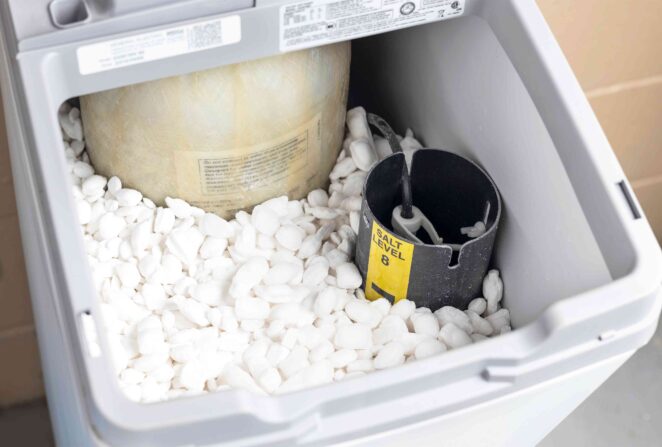
Water softeners are integral to maintaining the quality and longevity of your water supply and household appliances. Here’s why regular maintenance is crucial:
- Longevity: Routine maintenance significantly extends the lifespan of your water softener. Neglecting maintenance can lead to premature wear and tear, potentially requiring costly replacements.
- Efficiency: A well-maintained water softener operates at its optimal level, efficiently removing hardness minerals. This not only ensures the consistent softness of your water but also saves you money on energy and salt, as the unit functions more effectively.
- Water Quality: Maintenance is essential to ensure that your water remains soft and free from hardness minerals. This leads to a more enjoyable bathing experience, softer laundry, and cleaner dishes.
- Preventing Clogs: Regular maintenance is essential to prevent clogs and damage to the resin bed, which can affect the flow of water through your softener. By addressing issues early, you can avoid expensive repairs and ensure the unit continues to function as intended.
In essence, water softener maintenance is a critical aspect of maintaining the overall health and efficiency of your water softening system and, by extension, the quality of water in your home.
By investing time in routine upkeep, you can enjoy softened water consistently and extend the life of your water softener.
Signs Your Water Softener Needs Maintenance
Knowing when to maintain your water softener is crucial. Look out for these signs:
- Decreased Water Softness: If your water doesn’t feel as soft as usual, it’s time for maintenance.
- Salt Bridges: A hardened layer of salt can form in the brine tank, disrupting the softening process.
- Resin Beads Issues: Damaged or worn-out resin beads may cause reduced softening efficiency.
- Low Water Pressure: Clogs can develop in the resin bed, affecting water flow.
How to Perform Routine Maintenance
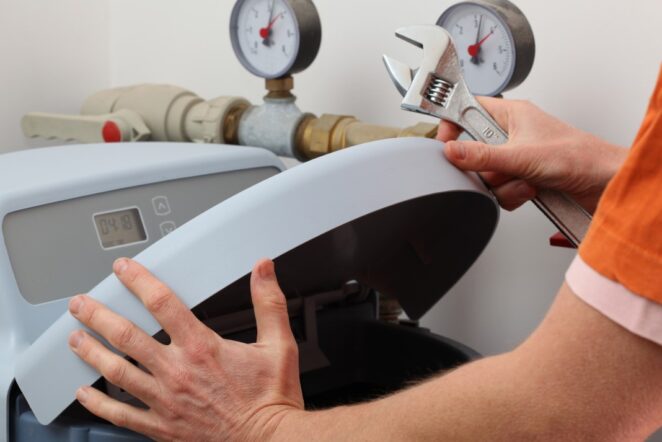
Regular maintenance is essential to ensure that your water softener continues to function at its best and provides you with high-quality softened water. Here’s a step-by-step guide to help you maintain your water softener:
Cleaning the Brine Tank
- Turn off the Water Softener: Before you begin, make sure to turn off the water softener to prevent any accidental regeneration during the maintenance process.
- Empty the Tank: Start by emptying the brine tank of any remaining salt. You can either use the salt for future use or discard it.
- Remove Contaminants: Check for any visible contaminants or salt bridges. Salt bridges are hardened layers of salt that can form in the tank, disrupting the softening process. Gently break up and remove these formations using a suitable tool, taking care not to damage the tank.
- Clean the Tank: Once you’ve removed salt and any contaminants, clean the tank’s interior with mild soapy water. Use a cloth or a scrub brush to remove any residue. Rinse the tank thoroughly to ensure no soap remains.
- Refill the Tank: After cleaning, refill the tank with the appropriate amount of salt as recommended by the manufacturer. It’s essential to maintain the right salt level to ensure the regeneration process works correctly.
Resin Bed Maintenance
- Inspect the Resin Bed: Examine the resin bed for any signs of damage or fouling. This is where the ion exchange process occurs, so it’s crucial to ensure it’s in good condition.
- Manual Regeneration: If you notice that the resin bed is fouled, initiate a manual regeneration cycle on your water softener. This process will help flush out contaminants from the resin bed and regenerate the resin beads.
- Use a Resin Cleaner: If the resin bed remains fouled after manual regeneration, consider using a resin bed cleaner. Follow the manufacturer’s instructions for the correct product and application method.
Checking and Replacing O-rings
- Examine O-rings: Inspect the O-rings for signs of wear, damage, or brittleness. These O-rings are typically found in the control valve and other areas of the water softener.
- Lubricate O-rings: Apply a silicone-based lubricant to the O-rings to keep them pliable and in good condition. This helps maintain a proper seal.
- Replace If Necessary: If the O-rings are severely damaged or worn out, replace them with compatible O-rings from your water softener’s manufacturer. This ensures that the seals remain effective, preventing leaks.
Regularly performing these maintenance tasks will help your water softener function optimally, prolong its lifespan, and provide you with consistently softened water.
It’s a worthwhile investment in ensuring the efficiency of your system and maintaining the quality of water in your home.
Troubleshooting Common Issues
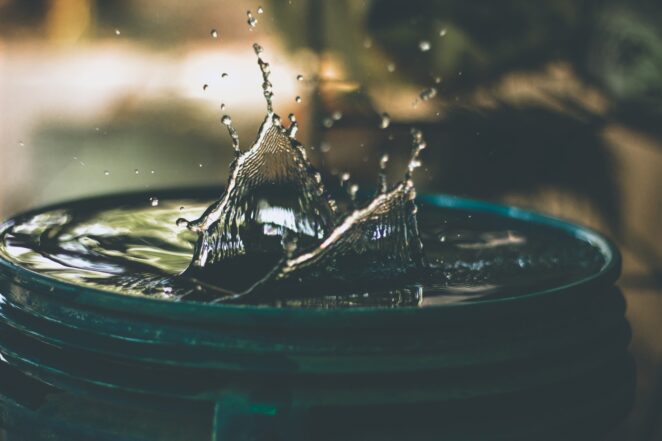
Common issues include low salt levels, leaks, and motor malfunctions. Troubleshoot and address these problems promptly to avoid major breakdowns.
The Benefits of Regular Maintenance
Regular maintenance ensures that your water softener operates efficiently, saving you money and improving the quality of your water. It also reduces the likelihood of costly repairs or replacements.
DIY vs. Professional Maintenance
While routine maintenance can often be done by homeowners, some issues may require professional assistance. A certified technician can handle complex problems and provide valuable insights.
Water Softener Salt Types
There are different types of salt available for water softeners, including rock salt, solar salt, and evaporated salt. Choosing the right salt type is important for optimal performance.
Water Softener Maintenance Tips
- Keep an eye on the salt levels.
- Check for leaks regularly.
- Perform routine maintenance at least once a year.
- Follow the manufacturer’s instructions for your specific water softener model.
Conclusion
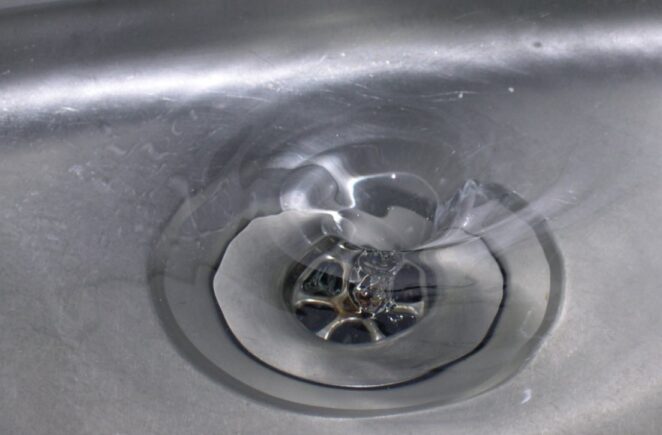
Proper water softener maintenance is vital to maintaining high water quality, extending the appliance’s lifespan, and preventing expensive repairs.
By following the maintenance tips provided in this article, you can enjoy the benefits of soft water consistently.



